The success of the Telesales Industry largely depends on good sales techniques. And as a key strategy of any business, Cross-Selling and Up-selling have a vital role in the Telesales field as well. These two powerful strategies allow businesses to leverage customer relationships already
“72% of those who upsell and 74% who engage in cross-selling attribute up to 30% of their revenue to these strategies.”
present while introducing new product offerings that can bring greater value to customers’ lives; ultimately leading them towards achieving higher levels of success in their various endeavors with the help of your product/service portfolio!
Basic Idea about the Telesales Industry

Telesales is a form of sales that involves making sales through phone calls. This industry is a subset of retail and business-to-business sales. Telesales representatives call potential customers, set appointments, and sell products or services over the phone.
This type of sales can be done for a wide range of products such as insurance, it involves cold calling, canvassing, and pitching to potential customers, and can be used to generate new business leads. This industry has become more tech-oriented in recent years with the use of automated call centers, internet-based sales tools, and other digital methods to streamline processes, minimize costs, and increase productivity.
Cross-Selling in Telesales
Cross-selling in telesales is when you offer customers additional products or services that complement what they’re already buying. Like, if someone buys a new phone, cross-selling would prompt them to also get a protective case and screen protector. It’s a good way to make more sales if you have other products or services that can go well with what the customer bought first.
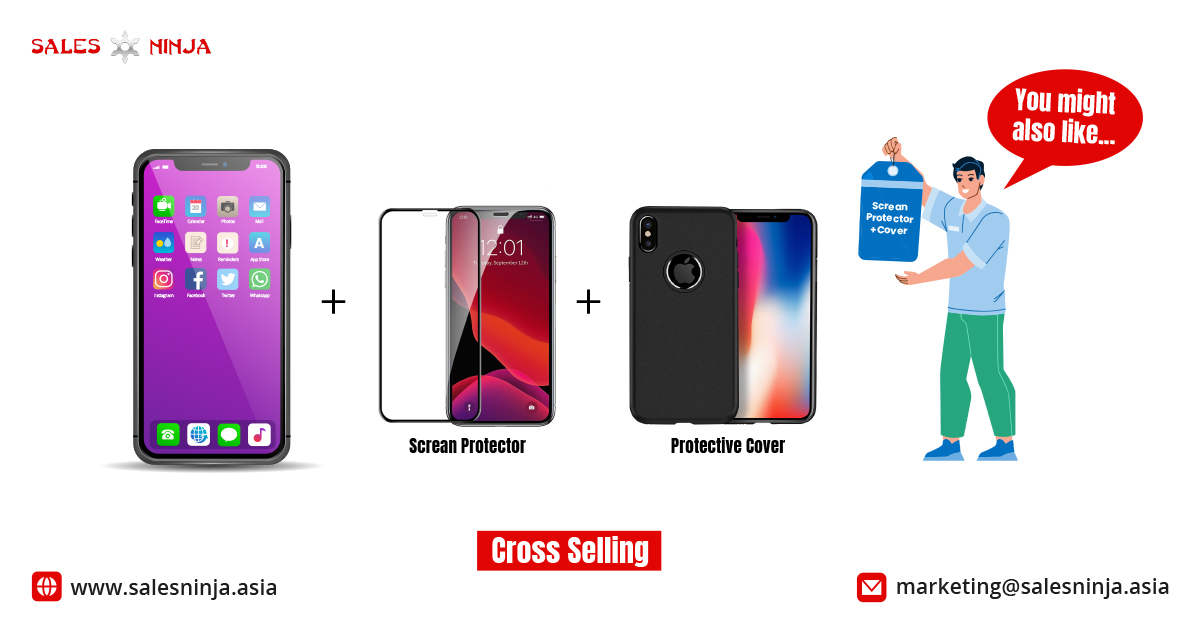
Cross-Selling: “How About Some Extra Goodies?”
Let’s imagine you’re a telesales agent for a company that sells high-end kitchen appliances. A customer calls in, excited to buy the latest model of a blender they’ve been eyeing for weeks. You process their order, and then you slide into the cross-selling.
“By the way,” you say in a friendly voice, “our premium blender does an amazing job with smoothies. Don’t miss out on our special deal for some great mixing bowls and a smoothie recipe book. They’re perfect for starting your healthy eating journey!”
In this scenario, you’re not trying to change their mind or push a more expensive blender. You’re offering items that complement their original purchase, enhancing their blending experience.
Examples
Imagine a customer who’s just signed up for a basic software subscription over the phone. A telesales rep could suggest adding on a training package or enhanced customer support to ensure they get the most out of their purchase.
Or, if a customer is ordering a dress, the rep might recommend a matching handbag or jewelry.
Upselling in Telesales
Upselling is when you encourage a customer to purchase a more expensive item or upgrade than they initially intended. It’s about enhancing the features or benefits of their purchase. Think of it as a customer is set on buying a basic smartphone model, and you suggest the latest version with a better camera and more storage for just a little extra cost.
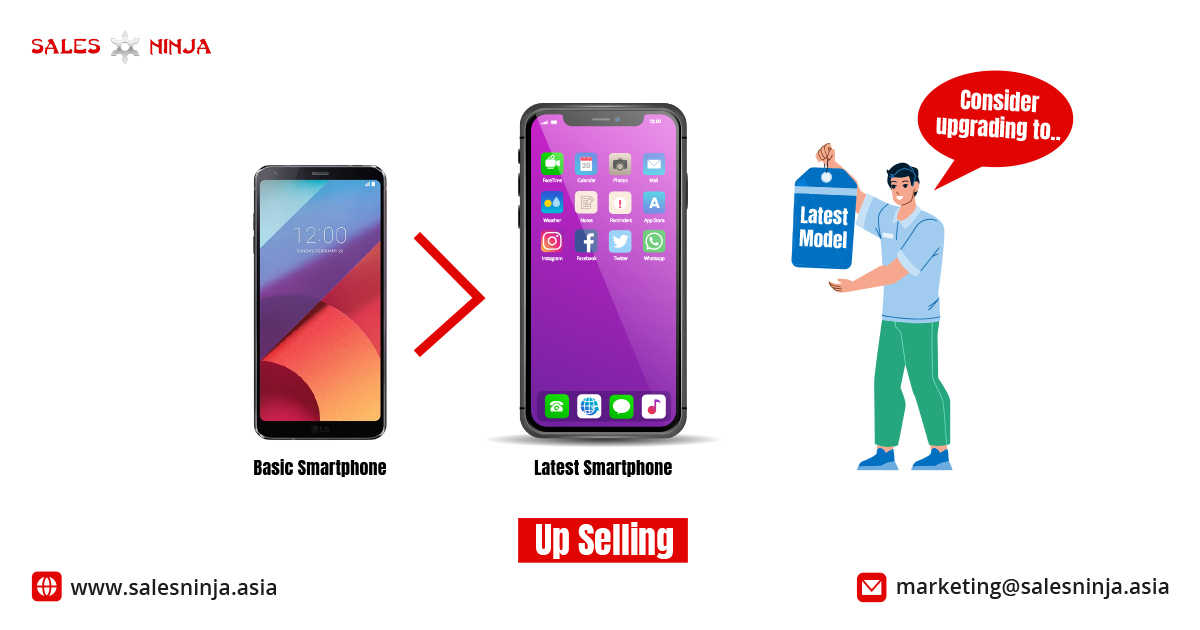
Upselling: “Get the Upgrade for Even Tastier Treats!”
Now, let’s take that same scenario but switch gears to upselling.
“Before I finalize your order,” you continue, “I noticed you chose the Basic Blender. It’s a fantastic choice. However, our customers have been raving about the Deluxe model. For just a little more, it comes with a built-in heater for soups and several smart features like a self-cleaning button. It’s the top choice for anyone who loves to blend a variety of foods beyond just smoothies. How about I upgrade you to that one?”
Here, you’re not introducing a new product; you’re offering a superior version of the item they’re already committed to buying. The idea is to enhance their initial decision by presenting a product that will deliver more value and possibly a better experience.
Example
A customer calls to renew a magazine subscription, and the telesales rep offers them an upgraded package that includes digital access on top of the print subscription.
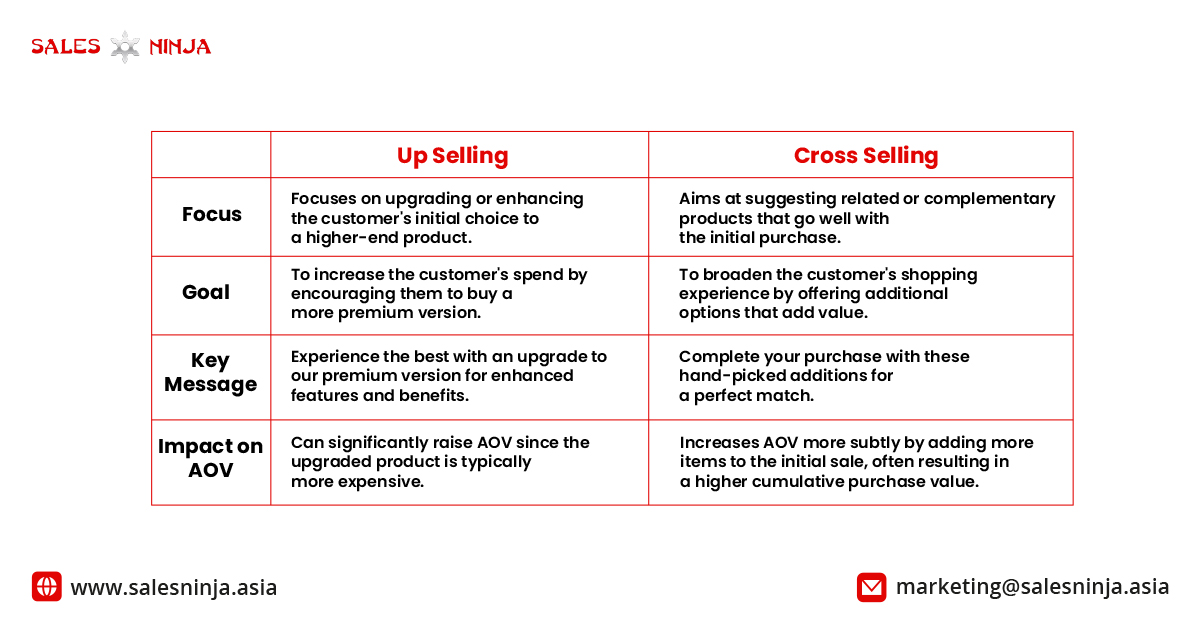
Cross-selling vs Up-selling
Why Cross-selling and Upselling strategies are important for business growth?
Cross-selling and upselling strategies are key for growth in sales organizations because they can significantly increase sales without the added expense of acquiring new customers. By offering additional, complementary, or premium products to existing customers, sales teams can deepen customer relationships and maximize the value of each sale.
This not only drives revenue but also enhances customer satisfaction, as clients appreciate the personalized attention and tailored solutions. Effective cross-selling and upselling can lead to a more diverse and stable revenue stream, contributing to the overall growth and success of sales organizations.
Benefits of Using Cross-Selling & Upselling Strategies in Telesales
Cross-selling and upselling are not just sales tactics; they are strategies to enhance the customer experience and boost your business’s bottom line. But what exactly do these benefits look like?
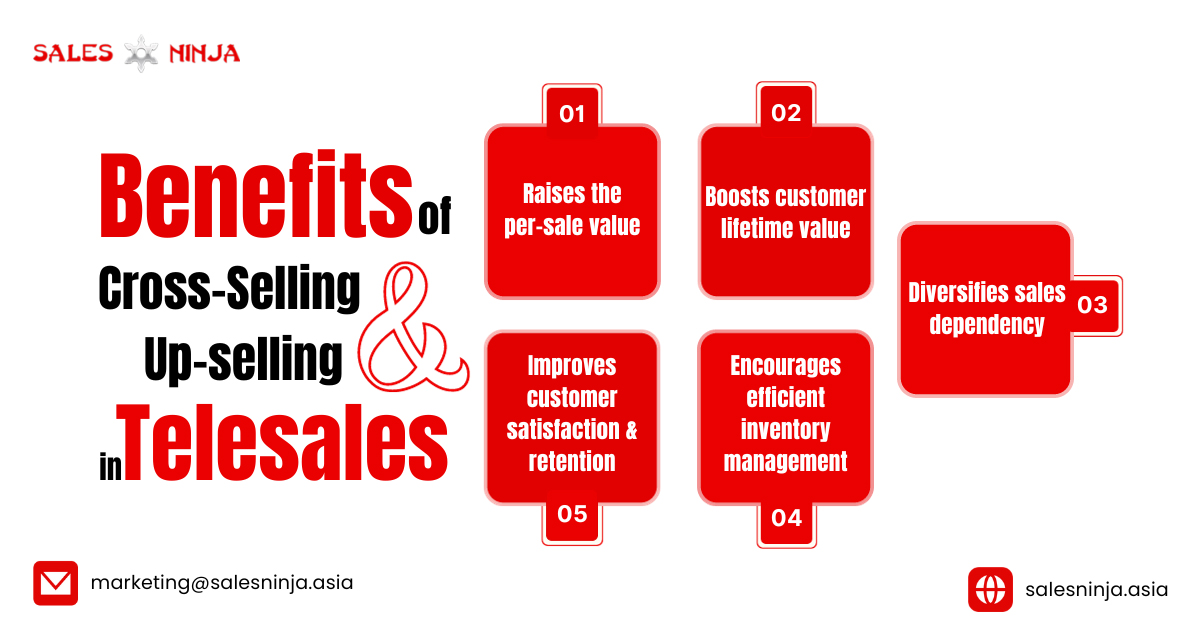
List of Benefits:
- Raises the per-sale value:
Every call you make has the potential to turn into a bigger payday. That’s what happens when you introduce cross-selling and upselling into your pitch. It’s about guiding your customer to see the value in adding a little extra to their basket or going for the premium option. The result? Your sales tally beefs up because you’re not just moving products, you’re increasing the value of each transaction.
- Boosts customer lifetime value:
Customers aren’t just one-time shoppers; they’re your ongoing revenue stream. By cross-selling and upselling effectively, you transform one-off purchases into a series of transactions over the lifetime of your customer. As you align your products to the evolving needs of your customers, you cement their loyalty. That means they’ll keep coming back, and the lifetime value of each customer grows.
- Improves customer satisfaction and retention:
When you cross-sell or upsell, you’re presenting options that enhance the customer’s initial purchase, adding layers of satisfaction. This personalization makes customers feel understood and valued, and as a result, they stick around. Happy customers become repeat customers, and they bring friends. So, you’re not just retaining a customer; you’re potentially multiplying them.
- Encourages efficient inventory management:
From a store management perspective, cross-selling and upselling are like the pulse that keeps the inventory alive and kicking. It helps move products that are lying dormant, pairing them with popular buys. This keeps your inventory fresh and dynamic, reducing the risk of dead stock and keeping the supply chain in tip-top shape.
- Diversifies sales dependency:
You know the saying about not putting all your eggs in one basket? Cross-selling and upselling embody that wisdom. By spreading sales across a wider range of products, you mitigate the risk of a slump in any one area. It diversifies your sales portfolio, so to speak, and ensures that your success isn’t hitched to a single star. It’s the strategic spread of sales that safeguards your revenue, come what may.
Statistics regarding Cross-selling and up-selling
Best Practices When Implementing Cross-Selling & Up-selling Strategies and Techniques
Now that we’re clear on their advantages, let’s dive into how we can put upselling and cross-selling into action effectively.
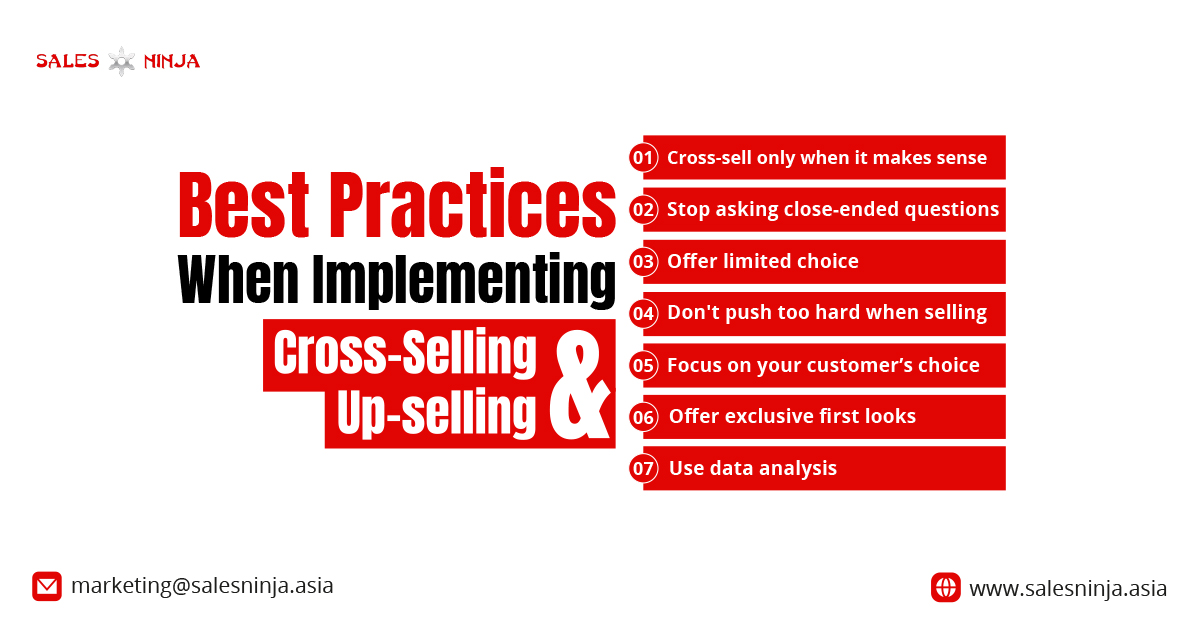
“Cross-sell only when It makes sense”
If a customer is shopping for a high-quality car freshener in your store, it wouldn’t make sense to suggest buying a whole new car sound system as an add-on. Cross-selling should be about enhancing the initial purchase without a massive jump in price.
A better approach would be to suggest items like a dashboard polish, a set of premium car mats, or even a travel mug that complements their driving experience. These items are related to the comfort and experience of being in the car, just like the freshener, but they don’t come with a hefty price tag. This way, the customer sees added value without feeling pressured to make a major additional investment.
“Stop asking close-ended questions”
When you are talking with the customer, it would be better if you stop asking questions that can be answered with a simple “yes” or “no.” Because asking “Do you want to buy something else?” won’t get you far.
Instead, try saying, “I’d love to share some other products with you that you might like based on what you’ve bought before.” This approach is more likely to get customers interested and can lead to more sales.
“Empower with Choices, but Don’t Overwhelm”
Keep it simple when you’re suggesting extra products or better versions. Offering too many choices can make it tough for people to decide. Stick to two or three that really fit with what they’ve already picked out.
When you’re trying to get more business, remember this: give people a few clear options, not a whole bunch. If you throw too much at them, they might get mixed up and not buy anything at all. So, it’s smart to just give them a few well-chosen recommendations.
“Don’t push too hard when selling”
It’s important not to be too aggressive when trying to make a sale. If you push a customer too much, you might scare them off. This kind of pressure can also harm your company’s good name. So, while it’s good to try your best to make a sale, remember that there’s a fine line between persuading someone and pushing them too far
“Pay attention to what your customers like”
When you’re trying to sell more or different products, make sure they’re things your customer actually wants or needs. If you push them to spend more without considering what they’re into, it’s not going to work out well.
But if you really listen and offer stuff based on what they’re interested in, you’re much more likely to hit your sales targets. So, remember, smart sellers always keep their customers’ tastes in mind.
“Offer Exclusive First Looks”
Treat loyal customers like insiders by giving them a sneak peek at new offerings before they’re available to the general public. This kind of exclusive access makes them feel special and appreciated, which not only tempts them to make additional purchases but also deepens their emotional investment in your brand.
When customers feel valued, they’re more likely to respond positively to upsell opportunities, because they trust that you’re offering them something truly worthwhile.
“Use data analysis”
Smart companies use data analysis to figure out what customers are likely to buy. It’s a smart move because it lets you see patterns in what customers have bought before, how they spend their money, and other important details. When you plan your sales strategies with this kind of information, you’re more likely to sell more because you’re offering customers what they’re really interested in.
Tips for increasing your chances of success when upselling or cross-selling in the Telesales Industry
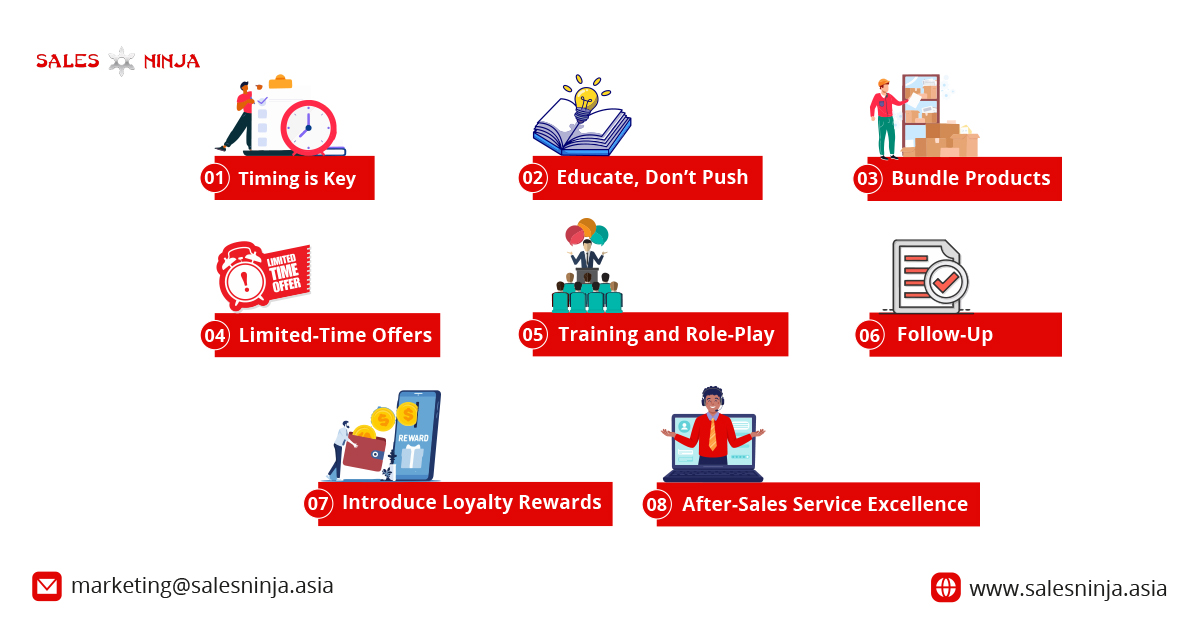
- Timing is Key: Introduce your upsell or cross-sell at a moment when the customer is
most satisfied with the conversation—typically after you’ve provided a solution or resolved an issue.
- Educate, Don’t Push: Instead of pushing a sale, educate the customer on how the
additional product or service adds value to their existing purchase.
- Bundle Products: Create bundles or packages that offer a better value proposition than
purchasing items separately.
- Introduce Loyalty Rewards: Propose loyalty points or rewards that can be redeemed on
future purchases if they opt for the upsell or cross-sell.
- Limited-Time Offers: Create a sense of urgency with limited-time offers that prompt
immediate action.
- Follow-Up: If a customer declines an upsell or cross-sell, make a note to follow up at a
a later time when they might be more receptive.
- Training and Role-Play: Regularly train your sales team on upselling and cross-selling
techniques. Use role-playing exercises to practice scenarios and refine their approach.
- After-Sale Service Excellence: Providing excellent service after the initial sale increases
the likelihood of successful future upsells or cross-sells.
Final Words
Cross-selling and upselling can be tricky. They work best when you choose the right moment, really understand your customer, and can put yourself in their shoes. If you’re tuned in to what your customer needs and you can tell when they’re open to suggestions, you’ll nail these sales techniques.




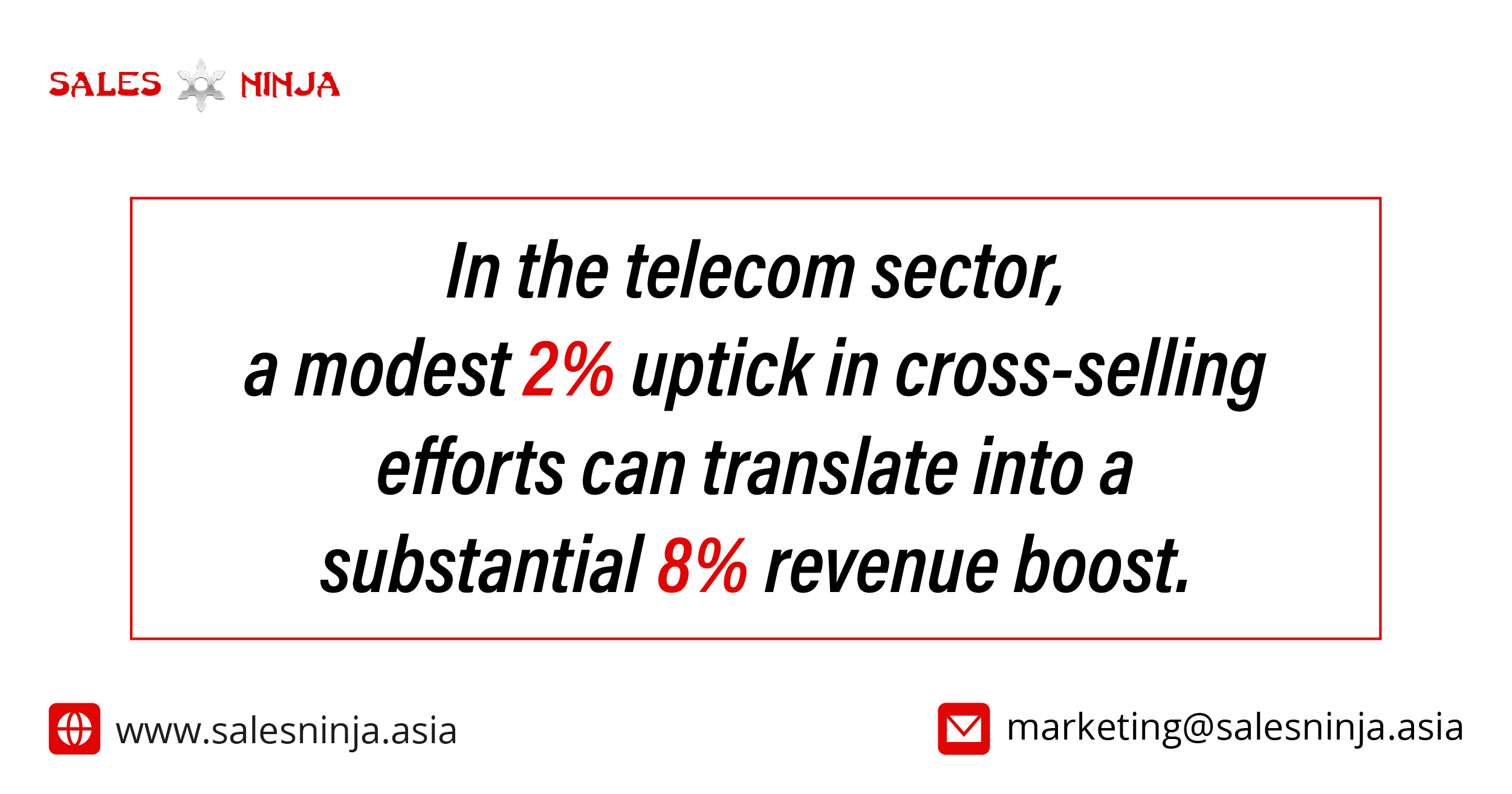








Leave A Comment